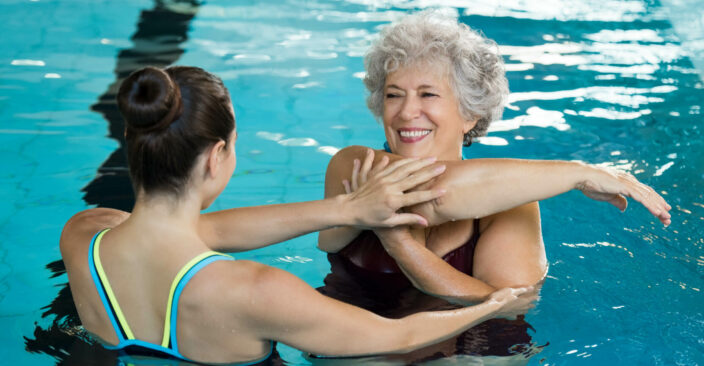Aquatic Exercises: Inpatient and Outpatient Support
Our CHS Aquatic Therapy Program serves as supplemental support to traditional, land-based therapy or as primary treatment. Basic aquatic principles of buoyancy, resistance, and hydrostatic pressure are applied to the biomechanics of movement patterns – all designed to improve function.
Year-Round Climate Control
All our Aquatic Centers are indoor and temperature controlled. You’ll enjoy year-round accessibility and avoid weather issues that could disrupt your rehabilitation hospital treatments.
- Leading-edge pools and therapeutic interventions
- Specialty trained physical and occupational therapists
Which Conditions Benefit From Aquatic Therapy?
Conditions which may benefit from aquatic therapy include, but are not limited to:
- Orthopedic conditions including fractures, joint replacement, amputations and soft tissue injuries
- Neurological conditions inclusive of CVA, brain injury, Parkinson’s disease
- Pain conditions and back injuries
- Debility due to medical complications and /or disuse, atrophy.
- Arthritis
- Diabetes
- Geriatrics
- Obesity
- Mastectomy
- Pre and Post Natal
Therapeutic Goals:
- Improvement of cardiopulmonary fitness
- Improvement in range of motion and muscle strength
- Improvement in gait
- Improvement in posture
- Decrease in pain
- Decrease in abnormal muscle tone
- Reduction in tactile defensiveness/hypersensitivity
- Improvement in balance, reaction time and safety during ambulation
- Improvement in flexibility
Specialized treatment techniques
A form of active aquatic therapy molded after the principle of Tai Chi and yoga breathing techniques
A form of active aquatic therapy which incorporates various exercises, activities and functional mobility in the water to improve awareness, coordination, gait, endurance, posture and trunk stabilization.
A form of active aquatic therapy modeled after the principles and movement patterns of Proprioceptive Neuromuscular Facilitation. The individual is instructed verbally, visually and /or tactilely in a series of functional, spiral and diagonal mass movement patterns while standing, sitting, kneeling or lying in the water.
A form of active or passive aquatic therapy. The individual is instructed in a series of movement or relaxation patterns while positioned horizontally and supported by rings or floats in the water.
A form of active aquatic therapy based on a walking program in the pool using a variety of strides and stretching exercises to increase overall fitness, to eliminate low-back and hamstring inflexibility, to improve postural alignment, and to strengthen the abdominals.
Benefits include:
- Enhancement of circulation which promotes healing
- Improves cardiovascular fitness which often accompanies injury or illness
- Impedes muscle atrophy and contractures which may occur in absence of exercise
- Application of weight bearing to upper and lower extremities in a graded or progressive manner
- Decrease in pain caused by muscle tension
- Assistance with movements of the limbs against gravity
- Application of resistance in a graded or progressive manner
- Reduction in spinal compression forces during exercise
- Decrease in muscle tone and spasticity
- Increase in amount of time to recover from loss of balance episodes
Next Steps: RX From Your Physician
To schedule CHS Aquatic Therapy on an outpatient basis, request a prescription for physical or occupational aquatic therapy from your physician.
